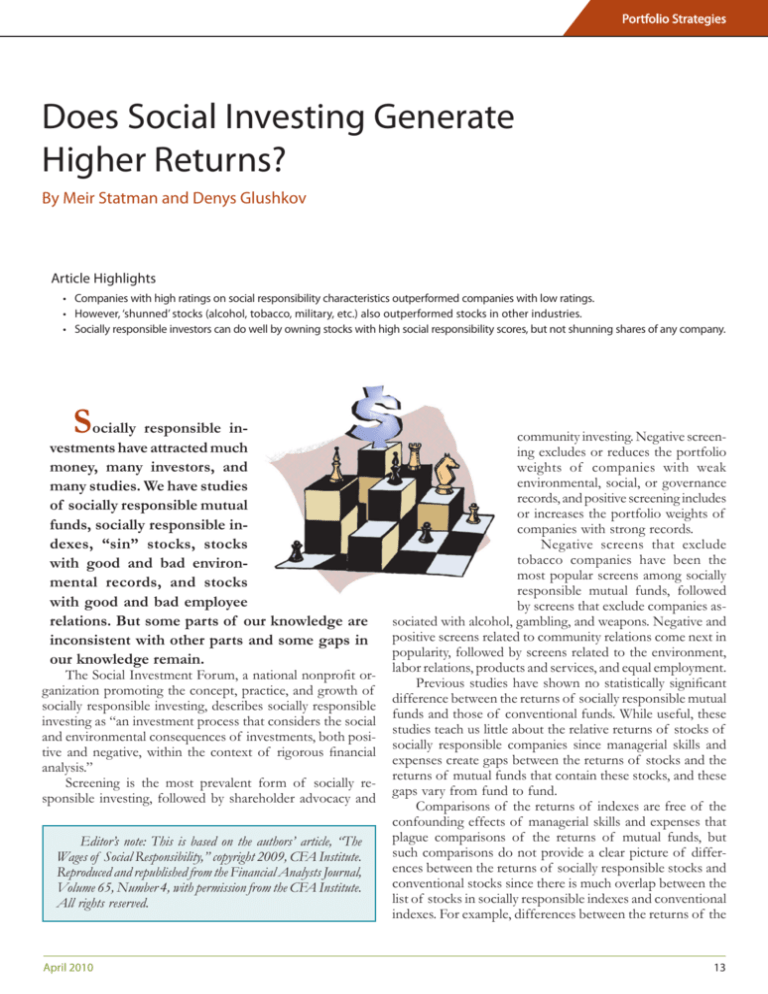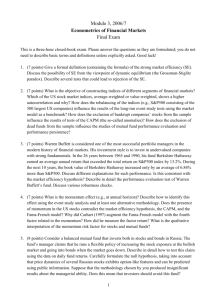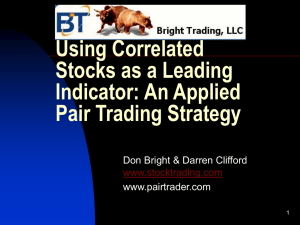
Portfolio Strategies
Does Social Investing Generate
Higher Returns?
By Meir Statman and Denys Glushkov
Article Highlights
• Companies with high ratings on social responsibility characteristics outperformed companies with low ratings.
• However, ‘shunned’ stocks (alcohol, tobacco, military, etc.) also outperformed stocks in other industries.
• Socially responsible investors can do well by owning stocks with high social responsibility scores, but not shunning shares of any company.
Socially responsible in-
vestments have attracted much
money, many investors, and
many studies. We have studies
of socially responsible mutual
funds, socially responsible indexes, “sin” stocks, stocks
with good and bad environmental records, and stocks
with good and bad employee
relations. But some parts of our knowledge are
inconsistent with other parts and some gaps in
our knowledge remain.
The Social Investment Forum, a national nonprofit organization promoting the concept, practice, and growth of
socially responsible investing, describes socially responsible
investing as “an investment process that considers the social
and environmental consequences of investments, both positive and negative, within the context of rigorous financial
analysis.”
Screening is the most prevalent form of socially responsible investing, followed by shareholder advocacy and
Editor’s note: This is based on the authors’ article, “The
Wages of Social Responsibility,” copyright 2009, CFA Institute.
Reproduced and republished from the Financial Analysts Journal,
Volume 65, Number 4, with permission from the CFA Institute.
All rights reserved.
April 2010
community investing. Negative screening excludes or reduces the portfolio
weights of companies with weak
environmental, social, or governance
records, and positive screening includes
or increases the portfolio weights of
companies with strong records.
Negative screens that exclude
tobacco companies have been the
most popular screens among socially
responsible mutual funds, followed
by screens that exclude companies associated with alcohol, gambling, and weapons. Negative and
positive screens related to community relations come next in
popularity, followed by screens related to the environment,
labor relations, products and services, and equal employment.
Previous studies have shown no statistically significant
difference between the returns of socially responsible mutual
funds and those of conventional funds. While useful, these
studies teach us little about the relative returns of stocks of
socially responsible companies since managerial skills and
expenses create gaps between the returns of stocks and the
returns of mutual funds that contain these stocks, and these
gaps vary from fund to fund.
Comparisons of the returns of indexes are free of the
confounding effects of managerial skills and expenses that
plague comparisons of the returns of mutual funds, but
such comparisons do not provide a clear picture of differences between the returns of socially responsible stocks and
conventional stocks since there is much overlap between the
list of stocks in socially responsible indexes and conventional
indexes. For example, differences between the returns of the
13
Domini 400 Social index (called DS 400
here; now the KLD 400) and the S&P
500 index likely understate differences
between the returns of stocks of socially
responsible companies and stocks of
conventional companies because the
two indexes share approximately 250
companies.
Moreover, social responsibility
criteria vary among indexes and so
do their relative weights. The Calvert
index assigns relatively high weight to
corporate governance, while the DS
400 index assigns relatively high weight
to the environment. The DS 400 index
excludes companies with any interests in
nuclear power plants, while the Calvert
index excludes such companies only if
their interests are substantial. And while
the DS 400, Calvert and Citizens indexes
exclude all tobacco companies, The Dow
Jones Sustainability index does not.
We sought to close the gap of
knowledge about returns associated with
characteristics of social responsibility,
such as diversity and employee relations.
We found that stocks of companies with
high ratings on social responsibility characteristics outperformed companies with
low ratings. However, we also found that
‘shunned’ stocks outperformed stocks
in other industries. ‘Shunned’ stocks are
defined more broadly than ‘sin’ stocks
as stocks of companies in the alcohol,
tobacco, gambling, firearms, military,
and nuclear industries. The two effects
largely balance out, such that socially
responsible indexes have returns that
are approximately equal to those of
conventional indexes.
Hypotheses About Stock
Returns
There are three alternative hypotheses about the relative returns of the
stocks of socially responsible companies
and conventional companies. The first
hypothesis is the “doing good but not
well” hypothesis, where the expected
returns of socially responsible stocks
are lower than the expected returns of
conventional stocks. This hypothesis
might be true if the benefits of company actions that tilt it toward social
14
responsibility fall short of the costs and
investors, on average, know that.
One study (by Amir Barnea and
Amir Rubin in 2006) described a scenario
where ordinary shareholders are shortchanged by their companies’ socially
responsible actions. But shareholders
might not be shortchanged. Instead,
socially responsible investors might be
willing to sacrifice returns for social
responsibility. Consider stocks of ‘sin’
companies associated with alcohol, tobacco and gambling. The activities of
such companies are seen as violating
social norm, and some socially responsible investors avoid them even if they
yield higher returns than stocks in other
industries.
The second hypothesis is the “doing good while doing well” hypothesis,
where the expected returns of socially
responsible stocks are higher than those
of conventional stocks. This is possible
if managers and investors consistently
underestimate the benefits of being
socially responsible or overestimate its
costs. For example, a company with high
employee satisfaction might generate
higher profits over the long term, even if
the perceived worker happiness increases
costs over the short term.
The third and last hypothesis is the
“no effect” hypothesis, where expected
returns of socially responsible stocks are
equal to the expected returns of conventional stocks. The “no effect” hypothesis
might be true if company actions that
tilt it toward social responsibility are
costless, such as when actions amount
to no more than words. The “no effect”
hypothesis might also be true when
costly company actions, such as better
employee relations, increase benefits by
as much as they increase costs, such that
company profitability is not affected.
This can happen, for instance, when the
extra costs of higher employee pay are
equal to the extra productivity benefits
of more satisfied employees.
The “no effect” hypothesis might
be true even if, in fact, the increase in
costs exceeds the increase in benefits, as
long as investors, on average, continue
to overestimate the benefits of social
responsibility actions or underestimate
their costs. Such overestimation of benefits or underestimation of costs might
come, for instance, from ‘rosy scenarios’
in the minds of socially responsible
investors who are overly optimistic
about the positive effects of employee
satisfaction on employee productivity.
Last, the “no effect” hypothesis
might be true if aspects of social responsibility that are consistent with the
“doing good while doing well” hypothesis are counterbalanced by other aspects
that are consistent with the “doing good
but not well” hypothesis. This is indeed
what we found.
Stocks of companies with good records on employee relations and similar
social responsibility criteria have earned
higher returns than stocks of companies
with poor records. This is consistent
with the “doing good while doing well”
hypothesis. But we also find that stocks
of ‘shunned’ companies—including
those of companies associated with
alcohol, tobacco and gambling—also
earned higher returns than stocks of
companies in other industries. This is
consistent with the “doing good but
not well” hypothesis. The two effects
counterbalance each other such that the
“no effect” hypothesis prevails.
Ranking Companies on Social
Characteristics
KLD Research and Analysis, Inc.
assigns a score of “1” when a company
demonstrates strength on an indicator
on its list of social characteristics (e.g.,
charitable giving) and zero if it does not.
Similarly, it assigns a score of “1” when
a company’s record raises concern on
an indicator on its list (e.g., investment
controversies) and zero otherwise. The
score of a company on a given characteristic is the difference between the
number of its strength indicators and
the number of its concern indicators.
The scores of companies in the DS
400 index of socially responsible companies were generally better than those
in the S&P 500 index of conventional
companies. The mean score of the DS
400 index companies was 0.65, higher
than the –1.55 mean score of the S&P
AAII Journal
Portfolio Strategies
500 index companies.
Investors are likely to continue to
debate which characteristics make a
company socially responsible, but the
distribution of the KLD scores of the
companies in the S&P 500 index and the
DS 400 index highlights the observation
that companies are arrayed in a range; no
company is perfectly socially responsible
or irresponsible. Moreover, companies
with the same overall KLD score differ
in their characteristics scores.
For each company each year, we
calculated the company’s score in each
of the seven characteristics of social
responsibility (community, diversity,
employee relations, environment, products, human rights, and governance) as
the difference between the number of
strength indicators and the number of
concern indicators. Our sample included
scores between 1991 and 2006.
Among the 2,955 companies are
198 companies ‘shunned’ because of
an association with tobacco, alcohol,
gambling, firearms, military or nuclear
operations. They include some companies that are members of the S&P 500
index, but not the DS 400 index.
Our classification of ‘shunned’
companies is broader than the stereotypical classification of ‘sin’ companies
which is the triumvirate of alcohol,
tobacco and gaming. Our classification
of shunned companies follows KLD and
includes not only companies associated
with defense or military operations but
also companies associated with nuclear
operations. Shunned companies are
those that KLD classifies as associated
with one or more of tobacco, alcohol,
gambling, firearms, military or nuclear
operations.
Performance of Socially
Responsible Portfolios
We find, in general, that stocks of
companies with high social responsibility
scores yielded higher returns than stocks
of companies with low scores. Excess
returns in equally weighted top-bottom
portfolios are positive and statistically
significant for the community, employee
relations and environment characteris-
April 2010
tics but not for the diversity and products
characteristics. Excess returns in the
human rights and governance characteristics are negative.
Evidence elsewhere on the relation
between corporate governance and
stock returns is conflicting. We find no
statistically significant relation between
governance and stock returns, consistent
with the “no effect” hypothesis.
Companies that rank high by community, employee relations, environment
and products tend to be growth companies, while those that rank high by
diversity, human rights, and governance
tend to be value companies. Companies
that rank high on community, employee
relations and diversity tend to be relatively large, while those that rank high
on environment, products, human
rights and governance tend to be small.
Companies that rank high on all social
responsibility characteristics tend to tilt
toward high momentum, but such tilts
are far from statistical significance.
The generally higher returns of
stocks of companies with high social
responsibility scores are especially
evident in a long-short portfolio of
companies that are ‘top-overall’ and
‘bottom-overall.’ We define a top-overall
company as one that is in the top third
of companies by two or more social
responsibility characteristics and not in
the bottom third by any characteristic.
Similarly, we define a bottom-overall
company as one that is in the bottom
third of companies by two or more
social responsibility characteristics and
not in the top third by any characteristic.
We exclude governance because it was
added to the KLD list only in 2002. The
portfolio is tilted toward growth stocks
and stocks with high momentum. But
there is no significant tilt toward large
or small-cap stocks.
Many socially responsible investors
shun stocks of companies associated
with alcohol, tobacco, or gambling, but
many also shun stocks of companies
associated with firearms, military or nuclear operations. We refer to companies
in these six groups as ‘shunned’ companies and refer to companies outside
these groups as ‘accepted’ companies.
We constructed a long-short portfolio
of stocks of ‘accepted’ and ‘shunned’
companies at the end of 1991, reconstituted it at the end of each subsequent
year and recorded its monthly returns
through the end of September 2007. We
find that the ‘accepted minus shunned’
portfolio had a negative annualized
excess return. The portfolio is tilted
toward small growth stocks. But there is
not much tilt toward momentum stocks
or away from them.
The effect on returns of the ‘positive screen’ of tilting toward stocks of
companies with high scores on social
responsibility characteristics offsets
somewhat the effect on returns of the
‘negative screen’ of excluding stocks of
‘shunned’ companies. We see that offset
in the performance of a portfolio long
in the socially responsible DS 400 index
and short in the S&P 500 index. The tilt
toward stocks of companies with high
scores on social responsibility characteristics increases the return of the DS 400
index relative to the return of the S&P
500 index by more than the exclusion
of ‘shunned’ companies from the DS
400 index decreases it. But the excess
returns of the DS 400–S&P 500 longshort portfolio have smaller magnitudes
than the excess returns of the top-overall
minus bottom-overall portfolio or the
‘accepted’ minus ‘shunned’ portfolio.
Management of Socially
Responsible Portfolios
Our findings indicate that portfolio managers who want to construct
high-performing socially responsible
portfolios should construct best-in-class
portfolios tilted toward stocks with high
social responsibility ratings. However,
practical portfolios deviate from the
portfolios we analyzed in several ways.
First, practical portfolios are likely
to be value weighted or close to value
weighted, while the portfolios we analyzed are equally weighted.
Second, practical portfolios deviate
from the portfolios we analyzed because
managers want portfolios with a high
likelihood of positive excess returns,
but they usually do not insist that such
15
likelihood be higher than common
statistical significance levels of 95% or
even 90%. A 60% likelihood of positive
excess returns is good, a 70% likelihood
is better, and a 95% likelihood is even
better.
Third, practical portfolio managers
want to assure themselves that excess
returns are robust, not due to positive
excess returns during the first half of
an overall period and negative excess
returns during the second half.
The signs of excess returns are
stable during the overall period, positive for the ‘top-overall minus bottomoverall’ and the ‘DS 400 minus S&P 500’
portfolios, and negative for the ‘accepted
minus shunned’ portfolios.
In sum, the results indicate that excess returns in value-weighted portfolios
are lower and less reliable than excess
returns in the equally weighted portfolio. However, excess returns continue
to favor best-in-class portfolios tilted
toward stocks with high social responsibility ratings.
Conclusion
Typical socially responsible portfo-
lios, such as the DS 400 index, are tilted
toward stocks of companies with high
scores on social responsibility characteristics such as community, employee
relations and the environment. We
analyzed returns during 1992–2007 of
stocks rated on social responsibility by
KLD and find that this tilt gave socially
responsible portfolios a return advantage
relative to conventional portfolios. This
finding is consistent with the “doing
good while doing well” hypothesis,
where the expected returns of stocks
of socially responsible companies are
higher than those of conventional
companies.
However, typical socially responsible portfolios also shun stocks of
companies associated with tobacco,
alcohol, gambling, firearms, military, and
nuclear operations. We find that such
shunning brings to socially responsible
portfolios a return disadvantage relative
to conventional portfolios. This finding
is consistent with the “doing good but
not well” hypothesis, where the expected
returns of socially responsible stocks
are lower than the expected returns of
conventional stocks.
The return advantage that comes
to socially responsible portfolios from
the tilt toward stocks of companies
with high scores on social responsibility
characteristics is largely offset by the
return disadvantage that comes to them
by the exclusion of stocks of ‘shunned’
companies. The net effect is consistent
with the “no effect” hypothesis where
expected returns of socially responsible stocks are approximately equal to
the expected returns of conventional
stocks. This is consistent with a world
where the social responsibility feature
of stocks has no effect on returns. But
it is also consistent with the world we
find, where return advantages of some
social responsibility criteria are offset
by return disadvantages of other social
criteria.
Socially responsible investors can
do both well and good by adopting the
best-in-class method for the construction of their portfolios. That method
calls for tilts toward stocks of companies
with high scores on social responsibility characteristics, such as community,
employee relations and the environment,
but refrains from calls to shun the stocks
of any company, even one that produces
tobacco.
Meir Statman is a Glenn Klimek professor of finance at Santa Clara University, Santa Clara, California. Denys Glushkov is a
research support director at Wharton Research Data Services, University of Pennsylvania, Philadelphia. Find out more about Meir
at www.aaii.com/journal/authors/statman.cfm.
16
AAII Journal







